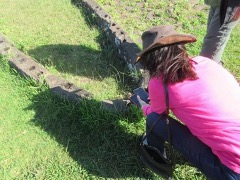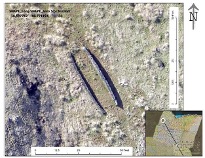- About MAA
- Membership
- MAA Publications
- Periodicals
- Blogs
- MAA Book Series
- MAA Press (an imprint of the AMS)
- MAA Notes
- MAA Reviews
- Mathematical Communication
- Information for Libraries
- Author Resources
- Advertise with MAA
- Meetings
- Competitions
- Programs
- Communities
- MAA Sections
- SIGMAA
- MAA Connect
- Students
- MAA Awards
- Awards Booklets
- Writing Awards
- Teaching Awards
- Service Awards
- Research Awards
- Lecture Awards
- Putnam Competition Individual and Team Winners
- D. E. Shaw Group AMC 8 Awards & Certificates
- Maryam Mirzakhani AMC 10 A Awards & Certificates
- Two Sigma AMC 10 B Awards & Certificates
- Jane Street AMC 12 A Awards & Certificates
- Akamai AMC 12 B Awards & Certificates
- High School Teachers
- News
You are here
Mathematical Mysteries of Rapa Nui with Classroom Activities: Mathematical Mystery 2 – Geometry of Hare Paenga (Boat House) Foundations
Even with all the reuse of the paenga stones, surviving ruins of complete or near-complete hare paenga foundations still exist. Within the literature, the foundations of the Rapanui hare paenga are said to be elliptical. However, at first glance in person, the ruins of a hare paenga looked too pointed on the ends and too straight on the sides to be an ellipse.

Figure 12. Ximena Catepillán checking the orientation of the remains of a hare paenga.
Nevertheless, after investigating with GeoGebra and Desmos, we discovered that it is possible to fit an ellipse to the shape of a stone foundation with the foci of the ellipse close to the ends of the major axis.
The GeoGebra applet below demonstrates fitting an ellipse to the remains of a hare paenga stone foundation. By moving points on the ellipse in the bottom center of the applet, in particular the magenta point that controls the minor axis of the ellipse and the red point which is one of the foci, one can adjust to get the corresponding ellipse on the picture in the upper left to match up with the archaeological ruins. Moving the green point traces out the ellipse. Watching the sum above the “Reset” button, while moving the green point, dynamically demonstrates the definition of the ellipse; namely, that the sum of the distances from a point on the ellipse to each foci is a constant.
We were also allowed access to some images of hare paenga obtained by Tukuh Technologies during their mapping. We used GeoGebra to fit ellipses to the images. (See the student activity "Curve Fitting Applied to Rapa Nui Stone Foundations" for the step-by-step procedure used.)


Figure 13. Images of hare paenga foundations. Courtesy of Tukuh Technologies, LLC.


Figure 14. Screenshots of results from using GeoGebra to fit an ellipse to the ruins.
Ximena Catepillán (Millersville University), Cynthia Huffman (Pittsburg State University) and Scott Thuong (Pittsburg State University), "Mathematical Mysteries of Rapa Nui with Classroom Activities: Mathematical Mystery 2 – Geometry of Hare Paenga (Boat House) Foundations," Convergence (March 2021)




